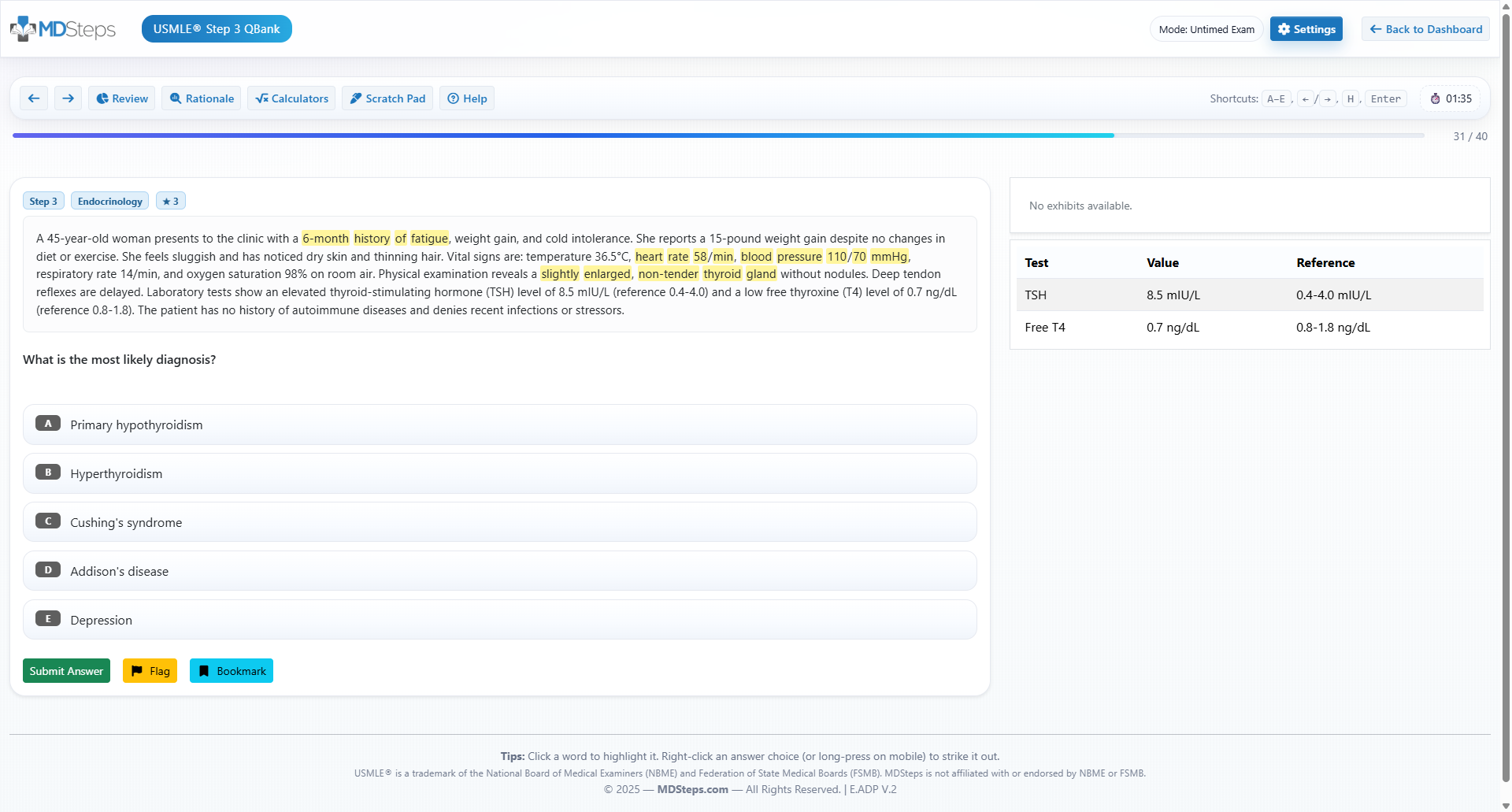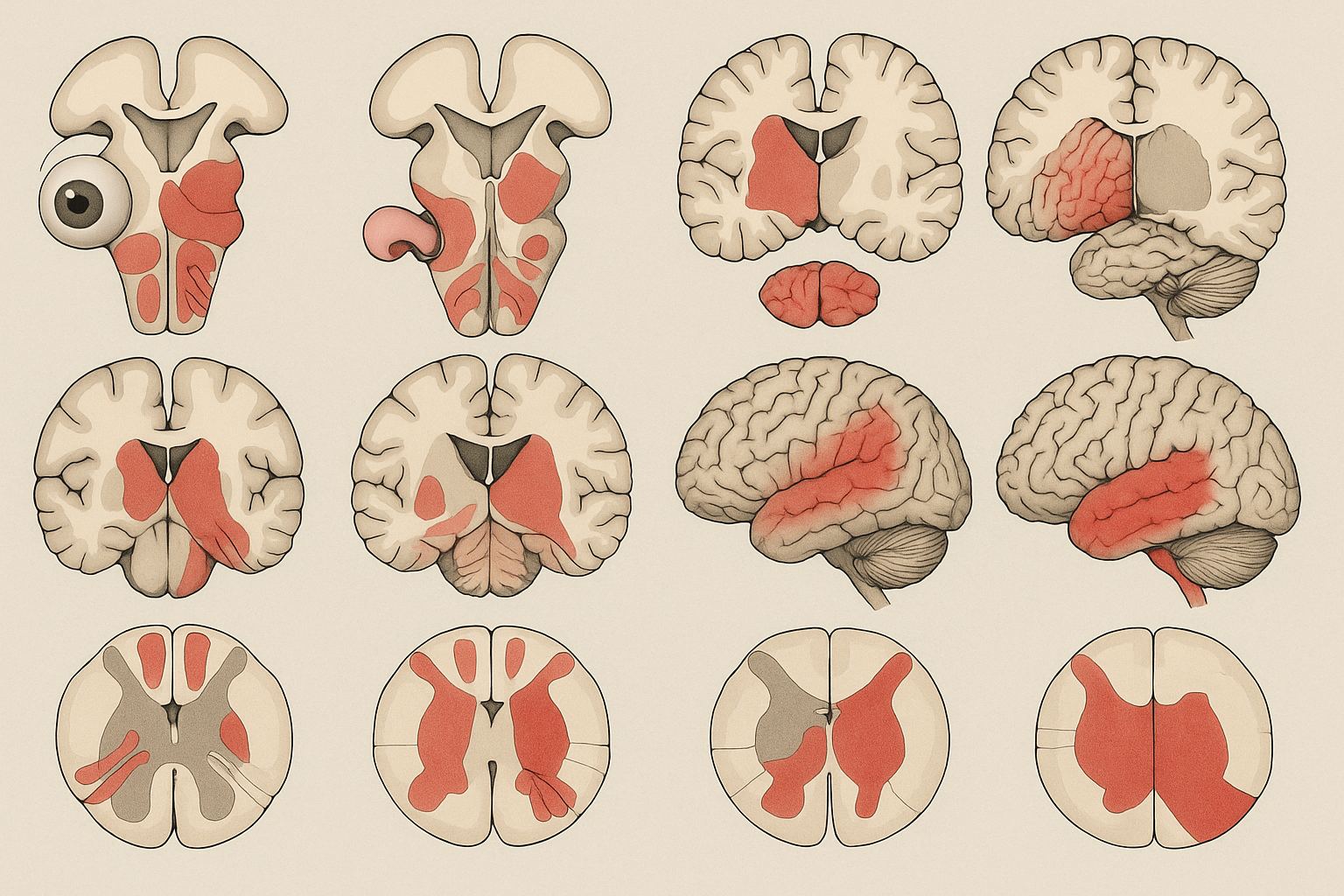A Pattern-First Approach to Bug–Drug Matching
Step 1 expects you to translate a vignette’s organism signal (Gram stain, shape, oxygen use, intracellular status), site (CNS, lung, urine, skin/soft tissue), and resistance flags (e.g., β-lactamase, mecA, VanA) into a short list of drug classes that work—and to know why alternatives fail. Rather than memorizing thousands of organism–drug pairs, anchor on three questions: (1) Does the organism even have the target that the drug class hits? (2) Can the drug reach the infected site at effective concentrations? (3) What is the canonical mechanism of resistance that knocks out the obvious choice?
Most first-pass choices fall out of a few tight rules. Cell-wall absent or atypical organisms (Mycoplasma, Chlamydia, Rickettsia, Legionella) ignore β-lactams; use protein synthesis inhibitors (macrolides, tetracyclines) or fluoroquinolones. ESBL-producing enterics knock out third-generation cephalosporins; carbapenems restore activity. MRSA alters PBP (PBP2a via mecA), making anti-staphylococcal β-lactams unreliable; vancomycin, linezolid, or daptomycin become default choices. Anaerobes below the diaphragm scream for metronidazole or β-lactam/β-lactamase inhibitor combinations. And Pseudomonas needs dedicated anti-pseudomonal agents (e.g., piperacillin-tazobactam, cefepime).
Board writers love why not questions. You must know the failure modes: aminoglycosides require oxygen (don’t work in strict anaerobes), daptomycin is inactivated by pulmonary surfactant (bad for pneumonia), and vancomycin fails in VanA/VanB Enterococcus (D-Ala→D-Lac substitution). Tissue penetration is equally testable: nitrofurantoin concentrates in urine (great for cystitis, not for pyelonephritis or systemic infections); ceftriaxone enters CSF (meningitis coverage), whereas first-generation cephalosporins do not.
If you see… think…
- Atypical pneumonia + low sodium → Legionella → macrolide or fluoroquinolone
- Post-influenza necrotizing pneumonia → MRSA → vancomycin/linezolid
- Intra-abdominal abscess → anaerobes → metronidazole or piperacillin-tazobactam
- Green nail puncture through sneaker → Pseudomonas → ciprofloxacin/antipseudomonal β-lactam
- Cystitis in pregnancy → avoid TMP-SMX (1st trimester) → nitrofurantoin or amoxicillin-clavulanate
Default filters
- Target present? (e.g., ribosome vs cell wall)
- Gets to site? (CSF, urine, lung, bone)
- Resistance? (β-lactamase, altered target, efflux)
- Toxicity/patient factors? (pregnancy, G6PD, QT, renal)
Gram-Positive Clusters & Chains: Staph, Strep, Enterococcus
Staphylococcus aureus. For MSSA, anti-staphylococcal β-lactams (nafcillin/oxacillin, cefazolin) are superior to vancomycin due to better killing. For MRSA, mecA encodes PBP2a, lowering β-lactam affinity; vancomycin (cell-wall synthesis inhibition), linezolid (50S), daptomycin (membrane depolarization), or ceftaroline (MRSA-active cephalosporin) are first-line choices. Daptomycin is inactivated by surfactant, so avoid in pneumonia; linezolid penetrates lungs and is bacteriostatic (watch for thrombocytopenia, serotonin syndrome).
Streptococci. Group A strep remains universally susceptible to penicillin; use penicillin/ampicillin for pharyngitis/soft tissue, or ceftriaxone for serious disease. Streptococcus pneumoniae increasingly resists penicillin via altered PBPs; high-dose β-lactams, ceftriaxone, or respiratory fluoroquinolones remain options depending on site/severity. Macrolide resistance via erm methylation (target modification) or mef efflux is common—use history clues (recent macrolide exposure) to avoid failures.
Enterococcus. Intrinsically less susceptible to cephalosporins. E. faecalis (ampicillin ± gentamicin synergy) is usually easier; E. faecium is tougher, frequently ampicillin-resistant and often VRE (VanA/VanB: D-Ala→D-Lac). For VRE, choose linezolid or daptomycin for bacteremia/endocarditis (dose high for high MIC). Vancomycin remains for non-VRE strains; cephalosporins are generally poor choices.
| Organism pattern | First-line | Why it works | Classic failure |
|---|---|---|---|
| MSSA bacteremia | Nafcillin/oxacillin or cefazolin | High PBP affinity; rapid killing | Using vancomycin when MSSA → slower kill |
| MRSA pneumonia | Linezolid or vancomycin | Bypasses PBP2a; lung penetration (linezolid) | Daptomycin in lung (surfactant inactivation) |
| VRE bacteremia | Daptomycin or linezolid | Membrane depolarization or 50S binding | VanA/VanB alters vanco target (D-Ala→D-Lac) |
| Strep throat | Penicillin/amoxicillin | No β-lactamase; PBP susceptible | Macrolide failure with erm/mef |
Exam traps: (1) “Necrotizing post-influenza pneumonia” → MRSA; (2) “Prosthetic device biofilm” → think rifampin added for biofilm penetration (never monotherapy); (3) “Penicillin allergy, non-anaphylactic” → cefazolin often still preferred for MSSA peri-op prophylaxis.
Enteric Gram-Negatives & ESBL/AmpC/KPC Logic
Enteric rods (E. coli, Klebsiella, Proteus) commonly cause UTI, intra-abdominal infection, and biliary sepsis. Third-generation cephalosporins (e.g., ceftriaxone) are workhorses unless resistance is signaled. ESBL (extended-spectrum β-lactamases) hydrolyze penicillins and most cephalosporins; carbapenems (meropenem, imipenem) reliably restore coverage. AmpC β-lactamases (e.g., Enterobacter, Citrobacter, Serratia) may be induced during therapy with third-generation cephalosporins; cefepime or a carbapenem is safer. Carbapenemases (KPC, NDM) blow past carbapenems; newer β-lactam/β-lactamase inhibitor combos (e.g., ceftazidime-avibactam) or non-β-lactam options may be needed (concept recognition only for Step 1).
Site matters. Uncomplicated cystitis can be treated with nitrofurantoin (concentrates in urine) or fosfomycin; avoid nitrofurantoin in pyelonephritis (poor renal tissue levels). Pyelo or urosepsis needs systemic agents (ceftriaxone, piperacillin-tazobactam, or a carbapenem if ESBL risk). In intra-abdominal infection, choose agents covering enterics and anaerobes (piperacillin-tazobactam, ertapenem/meropenem, or ceftriaxone plus metronidazole).
| Resistance flag | Avoid | Prefer | Board-style clue |
|---|---|---|---|
| ESBL (+) | 3rd-gen cephalosporins | Carbapenem | Prior cephalosporin use; recurrent UTIs |
| AmpC risk | Ceftriaxone/cefotaxime | Cefepime or carbapenem | Enterobacter bacteremia on day 5 “breakthrough” |
| KPC/NDM | Most β-lactams | Advanced combos (recognize concept) | Outbreak + “carbapenemase gene” PCR |
| Uncomplicated cystitis | Fluoroquinolone (overkill) | Nitrofurantoin/fosfomycin | Dysuria, afebrile, no flank pain |
Exam traps: (1) “Elderly with urosepsis previously on multiple cephalosporins” → suspect ESBL; pick meropenem. (2) “Cystitis with normal vitals” → nitrofurantoin is enough; don’t escalate. (3) “Breakthrough bacteremia on day 4 of ceftriaxone with Enterobacter” → inducible AmpC; switch to cefepime.
Master your USMLE prep with MDSteps.
Practice exactly how you’ll be tested—adaptive QBank, live CCS, and clarity from your data.
- Adaptive QBank with rationales that teach
- CCS cases with live vitals & scoring
- Progress dashboard with readiness signals
Non-Fermenters & Pseudomonas: Knowing the True Anti-Pseudomonals
Pseudomonas aeruginosa and other non-fermenters (Acinetobacter, Stenotrophomonas) are classic Step 1 foils because many go-to β-lactams lack activity. Build an anchor list of drugs that do cover Pseudomonas: piperacillin-tazobactam, cefepime, ceftazidime, ceftolozane-tazobactam, aztreonam (Gram-negative only), meropenem/imipenem (not ertapenem), and selected fluoroquinolones (ciprofloxacin, levofloxacin). Aminoglycosides (gentamicin, tobramycin, amikacin) are active but primarily adjunctive; monotherapy in systemic infection is weak.
Resistance arises through porin loss (reduced drug entry), efflux pumps, and β-lactamases. Board stems hint at prior broad-spectrum exposure, indwelling devices, or characteristic settings (burn unit, ventilator-associated pneumonia, hot tub folliculitis). For Acinetobacter, carbapenem resistance is common; for Stenotrophomonas, TMP-SMX is the classically active agent (recognize the exception).
| Syndrome | Active choices | Avoid | Trap |
|---|---|---|---|
| HAP/VAP | Piperacillin-tazobactam, cefepime, meropenem | Ampicillin-sulbactam, ertapenem | “Ertapenem covers most things” (not Pseudomonas) |
| Hot-tub folliculitis | Often self-limited; ciprofloxacin if needed | Macrolides | Treating aggressively when mild |
| Puncture wound through sneaker | Ciprofloxacin or antipseudomonal β-lactam | First-gen cephalosporin | Missing the “rubber sole” Pseudomonas clue |
Exam traps: (1) Ertapenem is the lone carbapenem without Pseudomonas activity. (2) Aztreonam lacks Gram-positive/anaerobe coverage—pair appropriately. (3) “Prior imipenem exposure” + “rising creatinine” → consider selecting a non-nephrotoxic alternative or adjusting dose in renal impairment.
Anaerobes, Aspiration, and C. difficile: Above vs Below the Diaphragm
Anaerobe matching is a favored testing ground because the logic is simple and easy to trap. For oral anaerobes and aspiration pneumonia, clindamycin (50S inhibitor) is a classic choice, with amoxicillin-clavulanate as an excellent alternative in outpatient settings. For intra-abdominal anaerobes—especially Bacteroides fragilis—metronidazole (DNA strand breaks) or β-lactam/β-lactamase inhibitor combinations (piperacillin-tazobactam) provide reliable coverage. Carbapenems also cover anaerobes; ertapenem is convenient for polymicrobial intra-abdominal disease (not Pseudomonas).
Clostridioides difficile colitis is now treated first-line with oral vancomycin or fidaxomicin (concept recognition for Step 1). Metronidazole is relegated to less severe or resource-limited contexts. Beware clindamycin’s association with C. difficile—sometimes the right answer is to avoid it in a high-risk patient.
| Scenario | Prefer | Why | Don’t choose |
|---|---|---|---|
| Aspiration pneumonia (community) | Clindamycin or amox-clav | Excellent oral anaerobe coverage | Metronidazole monotherapy (misses aerobes) |
| Intra-abdominal abscess | Metronidazole + ceftriaxone or pip-tazo | Covers anaerobes + enterics | Clindamycin (weak for Bacteroides) |
| C. difficile colitis | PO vancomycin/fidaxomicin | High intraluminal drug levels | IV vancomycin (won’t reach colon lumen) |
Drug caveats: metronidazole has a disulfiram-like reaction with alcohol; avoid in first trimester when alternatives exist. Clindamycin’s major risk is C. difficile. Piperacillin-tazobactam covers anaerobes and enterics but not atypicals; pairing with macrolide or doxycycline isn’t indicated for intra-abdominal disease.
Atypicals & Zoonoses: When β-Lactams Don’t Apply
When the pathogen lives inside cells or lacks a conventional peptidoglycan wall, β-lactams falter. Mycoplasma pneumoniae lacks a cell wall: choose macrolides (azithromycin), tetracyclines (doxycycline), or fluoroquinolones. Chlamydia trachomatis and Chlamydophila pneumoniae are obligate intracellular organisms; doxycycline or macrolides are first-line. Legionella lives in macrophages; macrolides or fluoroquinolones achieve intracellular concentrations and treat both pneumonia and systemic signs (hyponatremia, GI symptoms).
Zoonoses follow a tight set of pairings: Rickettsia rickettsii (Rocky Mountain spotted fever) → doxycycline for all ages (life-saving; enamel staining risk is outweighed in severe disease). Coxiella burnetii (Q fever) → doxycycline. Brucella → doxycycline plus rifampin (intracellular persistence). Bartonella henselae (cat scratch) often self-limited; macrolides or doxycycline in complicated disease. Know that tularemia (Francisella) pairs with aminoglycosides, while Yersinia pestis can be treated with streptomycin or doxycycline.
Mechanistically, macrolides bind 23S rRNA of the 50S subunit; resistance via erm-mediated methylation blocks binding, and mef-encoded efflux lowers intracellular levels. Tetracyclines block the 30S A-site; resistance arises from efflux pumps (tetA) or ribosomal protection proteins. Fluoroquinolones inhibit DNA gyrase/topoisomerase IV; resistance involves mutations in gyrA/parC or efflux.
Exam traps: (1) “Walking pneumonia in college dorm” → macrolide/doxycycline; β-lactam won’t work (no wall). (2) “Febrile illness after hiking with rash on wrists/ankles spreading centripetally” → doxycycline now—don’t delay for serologies. (3) “Hyponatremia + diarrhea + pneumonia” → Legionella; pick azithromycin or levofloxacin, not amoxicillin.
MOA vs Resistance: Why Drugs Work—And Why They Fail
Boards reward mechanism literacy. If you can articulate how a class kills and how organisms dodge it, distractors fall away. β-lactams bind PBPs to block cross-linking; β-lactamases hydrolyze the drug, PBPs mutate (e.g., PBP2a in MRSA), or porins/efflux limit access (Gram-negatives). Glycopeptides (vancomycin) cap D-Ala-D-Ala; VanA/VanB swaps to D-Ala-D-Lac, reducing affinity. Aminoglycosides misread mRNA at 30S and are bactericidal; they require oxygen-dependent transport and fail in anaerobes or with modifying enzymes (acetylation, adenylation, phosphorylation). Tetracyclines block 30S A-site; efflux and ribosomal protection dominate resistance. Macrolides bind 23S rRNA at 50S; methylation (erm) and efflux (mef) undermine them. Fluoroquinolones target DNA gyrase/topoisomerase IV; mutations in gyrA/parC plus efflux drive resistance. TMP-SMX blocks folate synthesis at two steps; increased PABA production or altered enzymes reduce efficacy.
| Class | Primary MOA | Classic resistance | Board nugget |
|---|---|---|---|
| β-lactams | Inhibit PBPs → no cross-linking | β-lactamase; altered PBPs; porin loss | MRSA = PBP2a (mecA) → use vanc/linezolid |
| Vancomycin | Binds D-Ala-D-Ala termini | VanA/VanB → D-Ala-D-Lac | VRE needs linezolid or daptomycin |
| Aminoglycosides | 30S misreading; bactericidal | Modifying enzymes; anaerobe ineffectiveness | Require O2—won’t work in abscess core |
| Macrolides | 50S (23S rRNA) blockade | erm methylation; mef efflux | Inducible resistance → D-test logic with clinda |
| Fluoroquinolones | DNA gyrase/topo IV | gyrA/parC mutations; efflux | QT prolongation; tendon risk |
| TMP-SMX | Folate pathway blockade | Altered enzymes; ↑ PABA | Hyperkalemia; avoid late pregnancy |
Exam traps: Aminoglycosides + loop diuretics → ototoxicity. Chloramphenicol → aplastic anemia (rare but testable). Linezolid → MAOI activity (serotonin syndrome with SSRIs). Knowing one “signature toxicity” per class is often the key to a best answer.
Putting It Together: Site + Signal + Resistance (Exam-Day Framework)
On exam day, run a fast three-step triage: (1) Site (CNS, lung, urine, skin/soft tissue, intra-abdominal), (2) Signal (Gram/shape/oxygen; atypical vs typical; zoonotic clues), and (3) Resistance (β-lactamase, mecA, VanA, ESBL/AmpC, Pseudomonas risk). CNS implies ceftriaxone/cefotaxime (± vancomycin; add ampicillin for Listeria in neonates/elderly). Atypical lung implies macrolide/doxy/respiratory FQ; aspiration implies clindamycin or amox-clav. Urine splits into cystitis (nitrofurantoin/fosfomycin) vs pyelonephritis (systemic β-lactam or FQ). Intra-abdominal disease needs enteric + anaerobe coverage (ceftriaxone + metronidazole or piperacillin-tazobactam or a carbapenem).
| Syndrome | Default pick | Upgrade if… | Avoid |
|---|---|---|---|
| Adult meningitis | Ceftriaxone + vancomycin | Add ampicillin if Listeria risk | 1st-gen cephalosporin (poor CSF) |
| CAP (non-ICU) | Azithromycin or doxycycline | β-lactam + macrolide if comorbid | Amoxicillin alone for atypical clues |
| Cystitis | Nitrofurantoin | Fosfomycin if ESBL risk | Nitrofurantoin in pyelo |
| Intra-abdominal abscess | Ceftriaxone + metronidazole | Piperacillin-tazobactam or carbapenem | Clindamycin monotherapy |
Rapid-Review Checklist
- β-lactams fail in atypicals and in MRSA (mecA PBP2a).
- Vancomycin fails in VRE (VanA/VanB D-Ala→D-Lac).
- Daptomycin fails in pneumonia (surfactant inactivation).
- ESBL → choose a carbapenem; AmpC risk → cefepime/carbapenem.
- Ertapenem ≠ Pseudomonas; aztreonam lacks Gram-positive/anaerobes.
- Nitrofurantoin is for bladder only; not pyelonephritis.
- Macrolide resistance: erm (methylation) and mef (efflux).
- Aminoglycosides need O2 → no anaerobe activity.
Exam-day tip: When two choices both “cover,” pick the one that addresses the stem’s resistance clue or penetrates the target site best.






